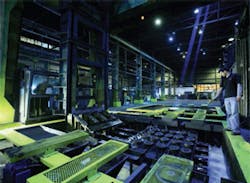The Dolhun brothers are relatively young men, but they’ve been involved with their family-owned commercial heat-treating businesses in the Milwaukee area for as long as they can remember. Their grandfather started Wisconsin Steel Industries in 1939, launching a three-generation tradition in heat treating. In 2007, T.J. and Jake Dolhun established a separate venture, Complete Heat Treating.
Both Wisconsin Steel and Complete Heat Treating serve regional manufacturers in the mining, construction, wind energy, rail, government- contract, medical, off-road, and agricultural equipment industries. They have international customers, too, including some as far away as Brazil. Their two operations employ about 50 people in total, and process materials like 4140 and 4340 steel forgings and castings weighing up to 100,000 lb. They also treat fabrications and some aluminum parts. Many value-adding secondary services are available too, including machining, straightening, roto-blasting and saw cutting, and metal coating.
Though pleased with their heat-treating ventures, T.J. and Jacob have been making significant improvements in the operations’ technical proficiency. They use a proprietary process-control software for their furnaces, they’ve incorporated several green initiatives for the operations, and a little more than a year ago they switched to Tenaxol as their polymer quenchant.
Wisconsin Steel and Complete Heat Treating operate 13 openfire, car-bottom and feed furnaces with capacities up to 1 million lb., with workspaces up to 52 ft. long × 20 ft. wide × 16 ft. high. Quench tanks at the two plants range up to 40,000 gallons.
Typically, hardness and mechanical specifications are supplied by the customers, and metallurgists and chemists in the labs at the two heat-treating plants determine the optimal processing conditions. Wisconsin Steel is rated to the GE Nuclear standards, and Complete Heat Treating recently earned ISO 9001:2008 certification.
The quenching operations at Complete were a particular challenge, owing to the large-scale parts processed there, the dwell times in the tanks, and recurrent problems with concentration flux — notably, foaming and drag-out. As T.J. explained, “We were having a lot of problems on one part, a spun metal component with thin but substantial surface area and a rimmed edge. The drag-out and the excessive foaming were causing us to rework parts to hit the ‘spec.’ There were shipping delays, and we were struggling to hold the concentrations in the tanks for any extended period.”
“Our stacker crane would come out of the tank full of foam,” Jacob detailed. “It looked like a bubble bath.”
Jacob continued the story: “We had been talking to Tenaxol about their anti-foaming products and, despite some cost differences with our then-current supplier, we agreed to testing. Although we were not their customer, the Tenaxol team really went the extra mile to give us the best results their lab could suggest.”
After the consultation Complete ordered a Tenaxol Quench 2500 Ultra polymer quenchant with a non-nitrite corrosion inhibitor, defoamer, and biocide, and the results have been outstanding. “We no longer have consistency issues, the percentages stay in line, plus we can vary the temperatures in the tanks without compromising performance. That opens more opportunities for new business, and it’s been working very well,” he said.
T.J. added that the drain-off of the Tenaxol product allowed the parts to enter the tempering furnace much faster, avoiding excess cooling of the surface area.”
Complete’s customer for that spun metal part, confirmed the improvement: “The turnaround time has been super,” according to Rich Prescott of Glenn Metalcraft. “They made great improvement in their deliveries to us over the last year, and that’s helped us satisfy our customers faster.”
“This anti-foaming agent in the Tenaxol product has literally changed our shop,” T.J. emphasized.
Jacob indicated satisfaction with Tenaxol’s customer service, too. “We get help from their lab on a regular basis, including water testing and support documentation, which is necessary for the PPAP requirements of several customers,” he pointed out. Tenaxol also addressed some problems with Complete’s cooling tower water by conducting lab tests, and automated equipment and chemical treatments.
Complete Heat Treating is currently hitting a record pace, with more customers and accelerated throughput for parts. Today, it boasts of a 25% increase in sales and working capacity, and it is able to process a wider range of materials, having adopted Tenaxol quenchants. On that spun metal part, T.J. noted, “We went from two weeks with a lot of rework to two days on a typical batch.”
And, Complete Heat Treating expanded its Tenaxol purchases to include various greases and lubricants. “The savings in staged deliveries alone run to thousands of dollars, each time,” Jacob added.
